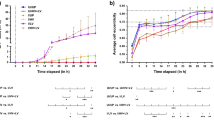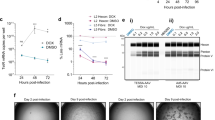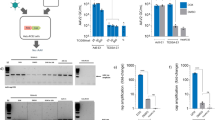Abstract
Recombinant adenoviruses provide a versatile system for gene expression studies and therapeutic applications. We have developed an approach that simplifies the generation and production of such viruses called the AdEasy system. A recombinant adenoviral plasmid is generated with a minimum of enzymatic manipulations, employing homologous recombination in bacteria rather than in eukaryotic cells. After transfection of such plasmids into a mammalian packaging cell line, viral production is conveniently followed with the aid of GFP encoded by a gene incorporated into the viral backbone. This system has expedited the process of generating and testing recombinant adenoviruses for a variety of purposes. In this protocol, we describe the practical aspects of using the AdEasy system for generating recombinant adenoviruses. The full protocol usually takes 4–5 weeks to complete.
This is a preview of subscription content, access via your institution
Access options
Subscribe to this journal
Receive 12 print issues and online access
$259.00 per year
only $21.58 per issue
Buy this article
- Purchase on SpringerLink
- Instant access to full article PDF
Prices may be subject to local taxes which are calculated during checkout




Similar content being viewed by others
References
Graham, F.L. & Prevec, L. Adenovirus-based expression vectors and recombinant vaccines. Biotechnology 20, 363–390 (1992).
Miller, A.D. Human gene therapy comes of age. Nature 357, 455–460 (1992).
Morgan, R.A. & Anderson, W.F. Human gene therapy. Annu. Rev. Biochem. 62, 191–217 (1993).
Breyer, B. et al. Adenoviral vector-mediated gene transfer for human gene therapy. Curr. Gene Ther. 1, 149–162 (2001).
Nadeau, I. & Kamen, A. Production of adenovirus vector for gene therapy. Biotechnol. Adv. 20, 475–489 (2003).
McConnell, M.J. & Imperiale, M.J. Biology of adenovirus and its use as a vector for gene therapy. Hum. Gene Ther. 15, 1022–1033 (2004).
He, T.-C. In Adenoviral Vectors in Current Protocols in Human Genetics Unit 12.4 12.4.1–12.4.21 (John Wiley & Sons, Inc., New York, 2001).
Shenk, T. Adenoviridae: The viruses and their replication . In Fields Virology. Vol. 2 (eds Fields, B.N. et al.) 2111–2148 (Lippincott-Raven, Philadelphia, 1996).
Graham, F.L., Smiley, J., Russell, W.C. & Nairn, R. Characteristics of a human cell line transformed by DNA from human adenovirus type 5. J. Gen. Virol. 36, 59–74 (1977).
Bett, A.J., Prevec, L. & Graham, F.L. Packaging capacity and stability of human adenovirus type 5 vectors. J. Virol. 67, 5911–5921 (1993).
Kochanek, S. et al. A new adenoviral vector: replacement of all viral coding sequences with 28 kb of DNA independently expressing both full-length dystrophin and beta-galactosidase. Proc. Natl. Acad. Sci. USA 93, 5731–5736 (1996).
Lieber, A., He, C.Y., Kirillova, I. & Kay, M.A. Recombinant adenoviruses with large deletions generated by Cre-mediated excision exhibit different biological properties compared with first-generation vectors in vitro and in vivo . J. Virol. 70, 8944–8960 (1996).
Graham, F.L. & Prevec, L. Methods for construction of adenovirus vectors. Mol. Biotechnol. 3, 207–220 (1995).
Ketner, G., Spencer, F., Tugendreich, S., Connelly, C. & Hieter, P. Efficient manipulation of the human adenovirus genome as an infectious yeast artificial chromosome clone. Proc. Natl. Acad. Sci. USA 91, 6186–6190 (1994).
Imler, J.L. et al. An efficient procedure to select and recover recombinant adenovirus vectors. Gene Ther. 2, 263–268 (1995).
Chartier, C. et al. Efficient generation of recombinant adenovirus vectors by homologous recombination in Escherichia coli . J. Virol. 70, 4805–4810 (1996).
Fisher, K.J., Choi, H., Burda, J., Chen, S.J. & Wilson, J.M. Recombinant adenovirus deleted of all viral genes for gene therapy of cystic fibrosis. Virology 217, 11–22 (1996).
Parks, R.J. et al. A helper-dependent adenovirus vector system: removal of helper virus by Cre-mediated excision of the viral packaging signal. Proc. Natl. Acad. Sci. USA 93, 13565–13570 (1996).
Miyake, S. et al. Efficient generation of recombinant adenoviruses using adenovirus DNA-terminal protein complex and a cosmid bearing the full-length virus genome. Proc. Natl. Acad. Sci. USA 93, 1320–1324 (1996).
He, T.C. et al. A simplified system for generating recombinant adenoviruses. Proc. Natl. Acad. Sci. USA 95, 2509–2514 (1998).
Hanahan, D. & Gluzman, Y. Rescue of functional replication origins from embedded configurations in a plasmid carrying the adenovirus genome. Mol. Cell. Biol. 4, 302–309 (1984).
Zeng, M. et al. AdEasy system made easier by selecting the viral backbone plasmid preceding homologous recombination. Biotechniques 31, 260–262 (2001).
Cheng, H. et al. Osteogenic activity of the fourteen types of human bone morphogenetic proteins (BMPs). J. Bone Joint Surg. Am. 85, 1544–1552 (2003).
Kang, Q. et al. Characterization of the distinct orthotopic bone-forming activity of 14 BMPs using recombinant adenovirus-mediated gene delivery. Gene Ther. 11, 1312–1320 (2004).
Luo, Q. et al. Connective tissue growth factor (CTGF) is regulated by Wnt and bone morphogenetic proteins signaling in osteoblast differentiation of mesenchymal stem cells. J. Biol. Chem. 279, 55958–55968 (2004).
Peng, Y. et al. Inhibitor of DNA binding/differentiation helix-loop-helix proteins mediate bone morphogenetic protein-induced osteoblast differentiation of mesenchymal stem cells. J. Biol. Chem. 279, 32941–32949 (2004).
Si, W. et al. CCN1/Cyr61 is regulated by the canonical Wnt signal and plays an important role in Wnt3A-induced osteoblast differentiation of mesenchymal stem cells. Mol. Cell. Biol. 26, 2955–2964 (2006).
Acknowledgements
We apologize to those authors whose original studies were not cited due to space constraints. R.C.H., H.H.L. and T.C.H. were supported by research grants from the American Cancer Society, the Brinson Foundation, and National Institutes of Health. T.C.H. was a recipient of the Outstanding Overseas Young Investigator Collaboration Award from the Natural Science Foundation of China (NSFC no. 30228026) and a recipient of the Bayu Scholar of Chongqing Municipality, Chongqing, China. K.W.K. and B.V. were supported by research grants from the National Institutes of Health and by the Virginia and D.K. Ludwig Fund for Cancer Research. For detailed information, please visit the AdEasy website: http://www.coloncancer.org/adeasy.htm.
Author information
Authors and Affiliations
Corresponding authors
Ethics declarations
Competing interests
The authors declare no competing financial interests.
Rights and permissions
About this article
Cite this article
Luo, J., Deng, ZL., Luo, X. et al. A protocol for rapid generation of recombinant adenoviruses using the AdEasy system. Nat Protoc 2, 1236–1247 (2007). https://doi.org/10.1038/nprot.2007.135
Published:
Issue date:
DOI: https://doi.org/10.1038/nprot.2007.135
This article is cited by
-
The Combinatorial Effect of Ad-IL-24 and Ad-HSV-tk/GCV on Tumor Size, Autophagy, and UPR Mechanisms in Multiple Myeloma Mouse Model
Biochemical Genetics (2024)
-
Lysyl oxidase inhibits BMP9-induced osteoblastic differentiation through reducing Wnt/β-catenin via HIF-1a repression in 3T3-L1 cells
Journal of Orthopaedic Surgery and Research (2023)
-
BMP4 upregulates glycogen synthesis through the SMAD/SLC2A1 (GLUT1) signaling axis in hepatocellular carcinoma (HCC) cells
Cancer & Metabolism (2023)
-
Thermogenic adipocyte-derived zinc promotes sympathetic innervation in male mice
Nature Metabolism (2023)
-
Two target gene activation pathways for orphan ERR nuclear receptors
Cell Research (2023)



